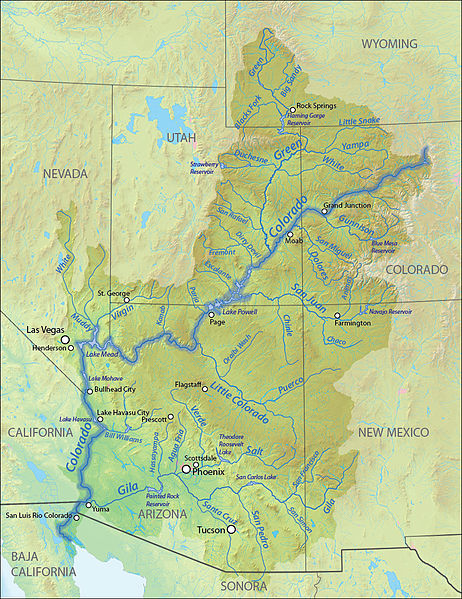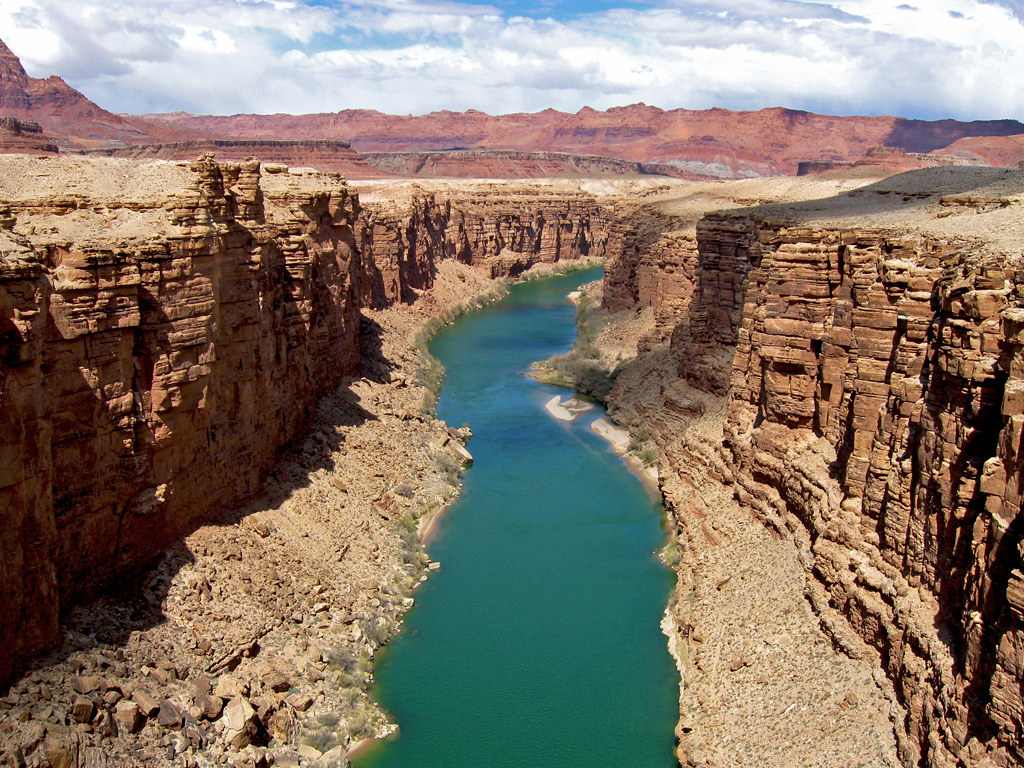Colorado River states again failed to arrive at a consensus plan for water use reduction. Watching how this unfolds will be instructive for navigating future resource shortages.
Have you been following the troubles out West? The region is stuck in a severe drought, which affects how much water the Colorado River can continue providing to the seven states that rely on its flow for everything from drinking water to industry to growing food for domestic use and export. The states involved – Arizona, California, Colorado, Nevada, New Mexico, Utah, and Wyoming – have had the chance to revise an old 2007 agreement, which was meant to be a short-term deal, or to create a new consensus plan with deeper cuts. All seven states have to sign off on any finalized pact, though, and so far, that has not happened. Meanwhile, the clock is ticking.
Last week, six of the states submitted a proposal, called the “Consensus Plan,” to the Bureau of Reclamation, detailing how they would divvy up the Colorado’s water while, ideally, not depleting Lake Powell and Lake Mead to the point that the river would no longer generate electricity or even stop flowing. There are just a few problems with the plan, though. First, other stakeholders who depend on the river, such as Mexico and several Native American tribal reservations, were not consulted. Second, California wouldn’t agree to the 25% use reduction and submitted its own, less austere plan instead. Third, the Consensus Plan wasn’t a long term solution. It’s just a duct tape veneer meant to buy a few more years until the drought resolves or a real agreement can be hammered out.
Spoiler: The drought isn’t going to resolve, at least not in the way a lot of people want it to. And no, one wet winter isn’t going to fix the drought, although it might make people stop paying attention.
This is the second time in less than a year that the states and other stakeholders have failed to reach an agreement for reality-based reductions in Colorado River water use. If a consensus plan cannot be reached, which looks likelier by the day, the Federal government will need to take the matter in hand. No doubt, any solution handed down from on high will be unpopular and satisfy nobody, especially if it takes into account realistic estimates of how much water the river can actually provide over time, losses through evaporation, and enforces the decision instead of continuing to kick the can down the road because no matter how the river is sliced up, it’s going to be painful.
Pain has a way of showing itself in politics, at least at first, and watching that unfold will be a lesson for the rest of the country.

California, as the state with the longest-established rights to the river and the highest priority granted to it in the 2007 agreement, has so far escaped mostly unscathed while other states, mainly Arizona, have had to make sacrifices. No amount of politicking will increase the amount of water coming down the Colorado, though, especially if we, as a global community, aren’t going to do what it takes to mitigate climate change in any real way. However, it’s not hard to envision a future where aggrieved residents of these seven states elect representatives who promise them the most water, and who pledge to force the harshest cuts on everybody else, instead. What could go wrong, and how long would it take for existentially threatened residents to move past politics and come to blows?
As one of the first major climate-based resource disruptions to affect the modern United States, though, the Colorado River crisis has another important lesson to teach: what overshoot is.
In 1922, policymakers looking to develop the southwest authored a previous agreement, the Colorado River Compact. Signed by all seven states, it divided up the water based upon gauge data from 1900 to 1920, which turned out to be two of the wettest decades in the last 1400 years. Starting with an inflated idea of how much water the river contained, the seven states distributed allotments of water that could not be sustained over the long term. With overly optimistic water promises in hand, states filled cities and subdivisions, planned for thirsty industries and agricultural endeavors, and attracted a population which eventually needed more water than the river could sustainably provide.
At first, it was easy to take a little extra water. There was so much. Over time, however, the cumulative effect of so many metaphorical straws sucking up a shrinking supply brought us to where we are today. Accordingly, any realistic consensus plan for water use is going to leave someone, perhaps many someones, high and dry. Nobody wants to be the loser, since losing means going out of business, having to move, or paying a whole lot more to have water shipped in from further away. The community of Rio Grande Foothills, which was built in tiny increments by developers sneaking past a 1980 law that required any subdivision with six or more houses to guarantee a 100-year water supply, is facing these hard choices. Their water supply was cut off by nearby Scottsdale, AZ, as part of Arizona’s water reductions that took effect on January 1.
As more and more residents and businesses face the reality of the western drought and a future of low to no water, the region will empty out to its natural carrying capacity, perhaps experiencing profiteering and conflict on the way back down. Laws and policy can be made, like the Consensus Plan, dividing water between all the interests in the region, but if that water doesn’t actually exist, those laws and policies will mean nothing. Watching how this plays out will be instructive when it comes to other resource shortages among overpopulated, over-consumptive regions in the future. Wise readers will adapt as best they can now to an uncertain future, and make their own “consensus plan” with friends, family, neighbors, and their larger communities, for managing the drawdown when shortages eventually come home to them.
Related: Colorado River States to Face Reckoning


Join the conversation!